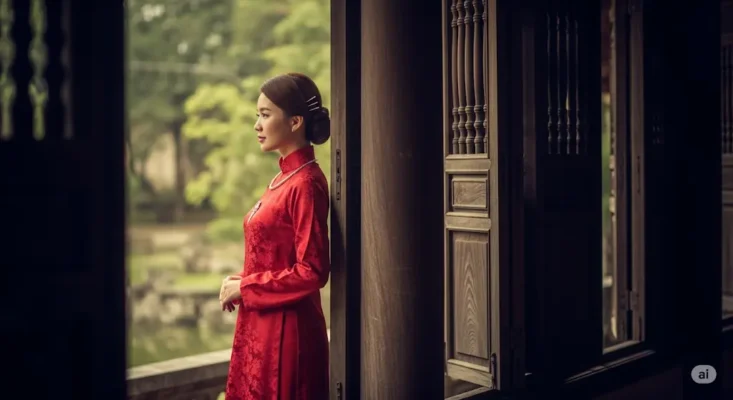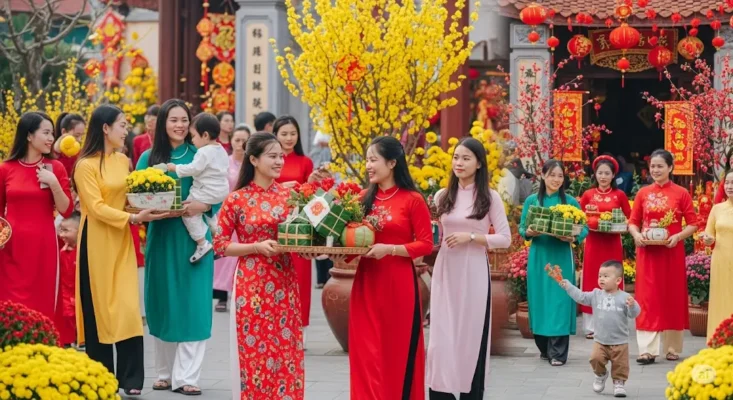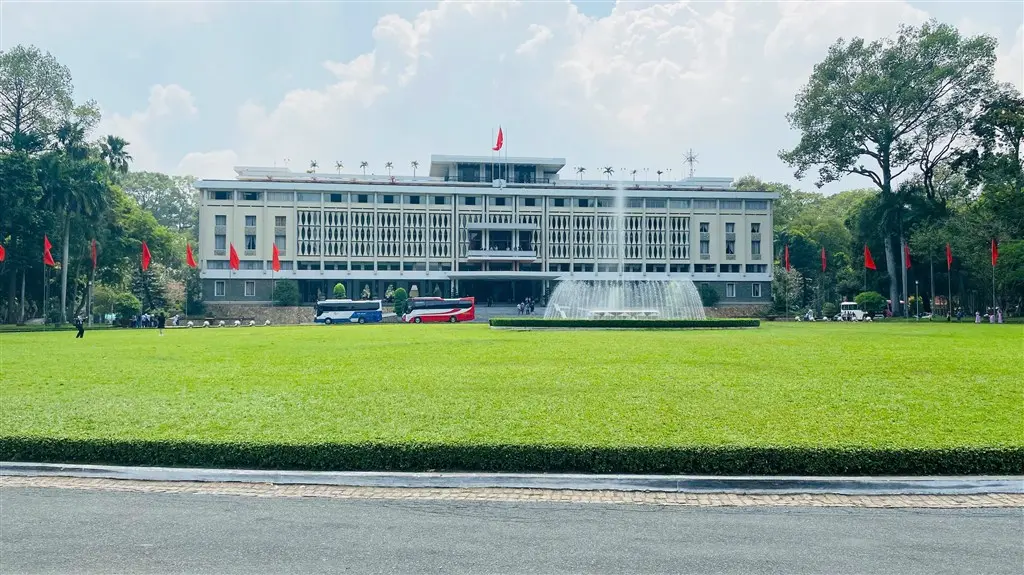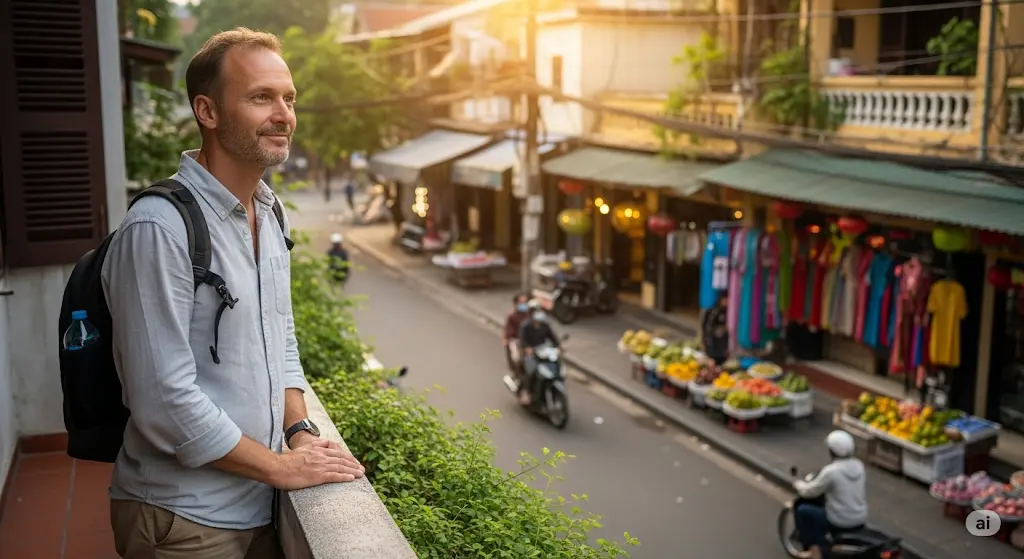The world recognizes certain garments as symbols of a nation. For Vietnam, the vietnamese traditional dress holds this honor. This clothing is not merely fabric stitched together. It represents history, art, and the spirit of a people. Understanding the vietnamese traditional clothing offers a window into Vietnamese culture. This guide, from EssentialVietNamtravel.com, aims to provide a clear view of this iconic Fashion.
We will explore the most famous example, the Ao Dai, and touch upon other forms of vietnam traditional attire. Many seek to Learn about Vietnamese traditional dress, and this article will serve that purpose.
Inspired to Witness Vietnamese Elegance?
See the beauty of Vietnamese traditional dress and the vibrant culture of Vietnam for yourself. Start planning your unforgettable journey today!
Find Flight Deals to Vietnam with WayAway
(Get cashback on your flight bookings!)
What is the Ao Dai: The Iconic Vietnamese Traditional Dress and its Meaning

The Ao Dai is perhaps the most recognizable vietnamese traditional dress. It is more than just vietnamese clothing; it is a profound symbol of Vietnamese identity and grace. Often simply called the vietnamese dress, its elegant silhouette is celebrated worldwide. The Ao Dai consists of a long, fitted tunic worn over wide-legged trousers.
This combination creates a unique look, distinct from other National costume styles in Asia. The term “Ao Dai” translates to “long tunic” or “long shirt,” a simple name for such a significant piece of vietnamese traditional wear.
The meaning of the Ao Dai extends beyond its physical form. It embodies Vietnamese femininity, modesty, and beauty. While there are versions for men, the Ao Dai is predominantly associated with Vietnamese women. The way the tunic flows, the snug fit that hints at the form without revealing, speaks to a particular aesthetic. It is a traditional vietnamese outfit that carries deep Cultural significance. Many people associate the ao dai vietnam with elegance and tradition.
It is a prime example of traditional vietnamese clothing that has endured through time, adapting yet retaining its core essence. The vietnamese áo dài is a testament to the enduring appeal of thoughtful design. When one speaks of vietnam traditional fashion, the Ao Dai is often the first image that comes to mind. This vietnamese garment is truly a treasure of Vietnamese culture. The dress of vietnam known as Ao Dai showcases Elegance.
Key Design Elements of the Ao Dai: Tunic, Trousers, and Form
The design of the Ao Dai is specific. Two main parts make up this vietnamese traditional dress: the tunic and the trousers. The tunic is a long garment. It fits closely to the body from the neck down to the waist. Below the waist, it splits into two panels, one at the front and one at the back. These panels flow down to the ankles, or sometimes even longer.
A key Ao Dai,Feature,High collar is common, though modern variations exist. Another important Ao Dai,Feature,Side slits allows for movement and creates the characteristic flowing effect. This Ao Dai,Component,Tunic is the star of the vietnamese outfit.
The trousers worn beneath the tunic are an essential Ao Dai,Component,Pants. These are typically wide-legged and made from a contrasting or complementary fabric and color. They provide comfort and modesty. The combination ensures the Ao Dai,Fit,Form-fitting nature of the tunic is balanced. The overall form of the vietnamese dress ao dai is one of grace. The long lines of the tunic elongate the figure. The flowing panels add a sense of movement and softness. This design is both practical and beautiful.
It allows for ease of movement while maintaining a dignified appearance. The traditional vietnamese fashion inherent in the Ao Dai’s design has captivated observers for generations. Understanding these elements helps one appreciate the vietnamese clothing culture. The vietnam style dress showcases a unique approach to Clothing. The vietnamese traditional outfit focuses on a slender silhouette.
The Symbolism and Cultural Significance Woven into the Vietnamese Ao Dai
The Ao Dai is not just clothing; it is rich with symbolism and Cultural significance. It stands as a powerful Cultural identity marker for Vietnamese people globally. Wearing the Ao Dai can evoke feelings of national pride and connection to Vietnamese heritage. It Represents Vietnamese identity in a very visual and immediate way.
Historically, the colors and materials of the Ao Dai could signify status or occasion. For example, a vibrant Ao Dai,Color,Red is often chosen for celebrations like Tet (Vietnamese New Year) or weddings, symbolizing luck and prosperity. The vietnamese traditional dress for wedding is often an elaborate Ao Dai.
The vietnamese traditional dress carries Vietnamese traditional dress,Symbolism,Elegance. Its form, often described as modest yet alluring, reflects societal values. The high collar suggests refinement. The close fit, achieved without being restrictive, speaks to a balance. The Ao Dai is a key part of vietnam culture clothing.
Its presence in art, literature, and daily life underscores its importance. For many, the vietnamese national dress is synonymous with the Ao Dai. The traditional clothes in vietnam often tell a story, and the Ao Dai tells a story of resilience, grace, and cultural pride. It’s a vietnamese cultural clothing piece that truly captures the essence of the nation. It is one of the most recognized costumes of vietnam.
Discovering Different Styles: Visual Examples of Vietnamese Clothing and National Attire from Vietnam

While the Ao Dai is the most famous, it is not the only form of vietnamese traditional dress. Vietnam has a diverse cultural landscape, and this is reflected in its National attire Vietnam. Exploring different styles provides a richer understanding of vietnamese clothing and its evolution. Many people Find Vietnamese traditional dress images online to appreciate the variety. These visual examples showcase Regional variations and adaptations of traditional vietnamese garments. The vietnam traditional clothing offers a spectrum of designs beyond the singular image of the Ao Dai.
From the simpler, everyday garments of rural communities to the more elaborate costumes once worn by royalty, vietnam clothing presents a fascinating study. The types of vietnamese traditional dress vary based on region, ethnicity, and historical period. Some older forms of ancient vietnamese clothing might look quite different from the modern Ao Dai.
For example, the Ao Tu Than (four-panel dress) or Ao Yem (a traditional bodice) are other significant pieces of vietnamese traditional wear. Each vietnamese garment has its own story and place within the broader context of vietnam culture clothes. Learning to Compare Vietnamese traditional dress styles reveals the depth of this aspect of Vietnamese culture. The national costume in vietnam encompasses more than one style, though the Ao Dai holds a special place.
Traditional Ao Dai Variations for Vietnamese Women and Men
The Ao Dai itself has variations. The most commonly seen is the vietnamese traditional dress female version. This style is celebrated for its elegance and femininity. The vietnamese women’s clothing version of the Ao Dai has seen many adaptations over the decades, with changes in collar height, sleeve length, and panel width. Some modern vietnamese traditional dress styles experiment with different fabrics and embellishments. The vietnamese female dress known as Ao Dai remains a popular choice for formal events and cultural celebrations. The vietnamese women’s dress is a key symbol.
However, there is also a vietnamese traditional dress male version. Historically, men wore Ao Dai styles that were often broader and made from sturdier fabrics. While less common in daily life today compared to the women’s version, the men’s Ao Dai is still worn for significant occasions, such as weddings or traditional ceremonies. This vietnam traditional attire for men emphasizes dignity and respect.
The traditional vietnamese outfits for men might include a headpiece like a Khan Dong. Seeing both male and female Ao Dai provides a complete picture of this important vietnam costume. The vietnamese outfits showcase a range of designs even within the Ao Dai category.
Regional Styles and Influences on Traditional Vietnamese Dress
Vietnam is a long country with distinct regions: North, Central, and South. These regions have historically had their own cultural nuances, which sometimes manifest in Regional variations of traditional vietnamese dress. For instance, the Ao Dai from Hue, the former imperial capital, might feature more regal designs or specific motifs influenced by the royal court. The vietnam dress style in Hue could incorporate Royal insignia or specific embroidery patterns.
The materials used might also vary. While Silk is a common Ao Dai,Material,Silk, other local textiles could be employed. The way the vietnamese traditional clothes are worn or accessorized can also show regional differences. For example, the type of Non La (conical hat) paired with the dress might differ slightly. Understanding these subtle distinctions adds another layer to appreciating the clothing of vietnam.
The traditional clothes of vietnam are not monolithic; they reflect the diverse tapestry of Vietnamese life. Differences in Specific dye techniques or Hand-embroidery details can also point to regional origins. This diversity is part of what makes vietnamese clothing culture so rich. The vietnam attire shows subtle shifts from one area to another.
The Enduring Legacy: History and Cultural Importance of Traditional Vietnamese Garments, especially the Ao Dai

The history of vietnamese traditional dress is long and fascinating. It mirrors the Vietnamese history itself, with periods of change, influence, and assertion of national identity. The Ao Dai, in its various forms, Originates from Vietnam and has evolved over centuries. Understanding this Historical evolution is key to appreciating its current form and Cultural significance. The vietnamese traditional dress did not appear overnight. It is the result of centuries of development.
Early forms of Vietnamese attire were simpler. Over time, influenced by various cultural exchanges and internal developments, garments became more refined. The Nguyen Dynasty (Vietnamese traditional dress,Historical Period,Nguyen Dynasty) played a significant role in shaping what we now recognize as the Ao Dai. It was during this period that rules of dress became more codified.
The Ao Dai became a symbol, not just of beauty, but also of social order and cultural values. The traditional vietnamese attire tells a story of survival and adaptation. Even through periods of foreign domination, the core elements of vietnamese traditional clothing often persisted, becoming symbols of resilience. The vietnam national dress has deep Historical roots.
Origins and Evolution of Vietnamese Traditional Dress through History
Tracing the precise origins of the earliest vietnamese traditional dress is complex, relying on historical texts, art, and archaeological findings. Early inhabitants of the region wore simple garments suited to the tropical climate. Over centuries, influences from neighboring cultures, particularly China, played a role, but Vietnamese artisans and wearers adapted these influences to create distinctly Vietnamese clothing. The Ao Tu Than, a four-panel dress, is considered an older form of traditional vietnamese wear.
The evolution towards the modern Ao Dai was gradual. Scholars point to the 18th century and the reforms of Lord Nguyen Phuc Khoat in the South as a key period. He mandated changes in attire to distinguish his people. Later, during the Nguyen Dynasty, the Ao Ngu Than (five-panel tunic) became prevalent among the aristocracy and officials. This is seen as a direct precursor to the modern vietnamese Ao Dai. In the early 20th century, artists and designers began to modernize the Ao Dai, leading to the sleek, two-panel version popular today. This traditional vietnamese outfit has a documented path of change. The clothes of vietnam show a clear lineage.
The Ao Dai as a Symbol of Vietnamese Identity and Tradition
The Ao Dai is more than just a piece of vietnam clothing; it is a powerful symbol of Vietnamese identity and Tradition. For Vietnamese people, both within Vietnam and in the diaspora, the Ao Dai evokes a strong sense of cultural belonging. It is a visual link to their homeland and heritage. When you see an Ao Dai, you see Vietnam. This vietnamese national dress is instantly recognizable and deeply cherished. It is a key part of Vietnamese culture clothes.
The Cultural significance of the Ao Dai is immense. It is worn on the most important occasions: weddings (Vietnamese traditional dress,Occasion,Wedding), Tet holiday celebrations (Ao Dai,Silk,Vietnam,Festival,Tet holiday), graduations, and other formal events. It represents grace, elegance, and national pride. The traditional clothes in vietnam, particularly the Ao Dai, are often featured in cultural performances and artistic expressions.
It serves as a Cultural identity marker, distinguishing Vietnamese culture on the world stage. The vietnamese garment is a source of pride. This vietnam traditional costume plays a role in maintaining cultural continuity. The costume in vietnam known as the Ao Dai carries significant weight.
The Art of Silk: Crafting the Authentic Vietnamese Traditional Dress
The beauty of a vietnamese traditional dress, especially the Ao Dai, is often inseparable from the material it is made from. Silk is the quintessential fabric for the Ao Dai. The way Ao Dai,Material,Silk drapes and flows is crucial to its characteristic elegance. The Craftsmanship involved in creating an authentic traditional vietnamese dress is considerable, often involving skilled tailors and sometimes intricate handiwork.
The choice of fabric, the precision of the cut, and the skill of the seamstress all contribute to the final garment. A well-made Ao Dai is a work of art. It fits the wearer perfectly, accentuating their form while maintaining modesty. The vietnam cloth chosen, particularly silk, can vary in weight and texture, influencing the look and feel of the vietnamese traditional clothing. From selecting the right Silk to the final stitch, creating a vietnamese dress traditional is a meticulous process. The vietnamese ao yai (a phonetic variation of Ao Dai) shines when made with quality materials. Textile art is central to the beauty of this vietnamese attire.
The Role of Silk in Creating the Elegance of Vietnamese Attire
Silk plays a pivotal role in achieving the signature Elegance of the Ao Dai. Its natural luster, smooth texture, and lightweight quality make it ideal for the flowing panels of the tunic and the soft drape of the trousers. Ao Dai,Fabric Weight,Lightweight is a common characteristic. When a woman wearing a silk Ao Dai moves, the fabric seems to float around her, creating an ethereal and graceful effect. The vietnamese traditional dress made from silk has a distinct feel and appearance that other fabrics cannot easily replicate.
Different types of silk can be used, from shimmering satins to textured brocades, each adding a unique character to the vietnamese garment. Hand-embroidery details on silk Ao Dai are particularly prized, showcasing intricate patterns of phoenixes, lotuses, or other symbolic motifs. The Phoenix and Lotus are common symbols in Vietnamese culture. The choice of silk also speaks to the Tradition of sericulture in Vietnam, a craft with deep historical roots. This connection between material and garment elevates the vietnam style of dress. The fashion in vietnam often highlights the beauty of natural fibers like silk.
Traditional Techniques and Craftsmanship in Making an Ao Dai
Creating an Ao Dai is a testament to skilled Craftsmanship. It is not simply a matter of sewing pieces of fabric together; it requires precision and an understanding of how the garment should fit and flow. Traditionally, an Ao Dai is custom-made. A tailor will take meticulous measurements to ensure the Ao Dai,Fit,Form-fitting aspect is perfect. This tailoring skill has been passed down through generations. Unknown folk artisans were the original Vietnamese traditional dress,Designer,Unknown folk artisans.
The process involves careful cutting of the fabric, especially for the fitted bodice and the flowing panels. The high collar requires skill to construct neatly. Details like button loops, often made of fabric, and the precise finishing of seams are marks of a quality traditional vietnamese outfit. For more elaborate Ao Dai, techniques like hand embroidery or painting on silk are employed, adding to the garment’s value and uniqueness. These Specific dye techniques and handwork reflect the Art aspect of vietnamese clothing culture. The clothing from vietnam made with such care is truly special.
Wearing the Tradition: The Ao Dai in Modern Vietnam, Festivals, and Celebrations

The Ao Dai is not merely a historical artifact. It is a living part of Modern adaptations in Vietnam. While not everyday wear for everyone as it once was, the vietnamese traditional dress remains highly visible and significant, especially during Festival times and important personal milestones. Many people Buy vietnamese traditional dress online or from local tailors for these occasions. The vietnamese traditional wear continues to be cherished.
You will see the Ao Dai at weddings, engagement parties, and school graduations. It is a common sight during Tet holiday (Vietnamese New Year), when people wear their finest vietnamese new year outfits to visit family and temples. The vietnamese new year dress is often a new Ao Dai, symbolizing a fresh start. Female students in many high schools across Vietnam still wear a white Ao Dai as their uniform, a beautiful and enduring tradition. The vietnamese new year clothes often feature bright, auspicious colors. The traditional dress in vietnam is actively worn and celebrated.
When and Where is the Vietnamese Traditional Dress Worn Today?
Today, the vietnamese traditional dress, particularly the Ao Dai, is most commonly seen during special events. Vietnamese traditional dress,Occasion,Wedding is a prime example, where brides, grooms (in a male Ao Dai), and guests often don this elegant Attire. Tet holiday is another key time; streets in cities like Hanoi and Hue will be filled with people in colorful Ao Dai. It is also standard vietnamese formal wear for many official functions, cultural performances, and by staff in upscale hotels and restaurants seeking to provide an authentic Vietnamese welcome.
Schoolgirls in their white Ao Dai are a daily sight in many parts of Vietnam, symbolizing purity and grace. For many Vietnamese women, owning at least one Ao Dai is essential for attending important social and family gatherings. The vietnamese garmet is also popular for photo shoots, especially in scenic or historical locations, capturing a timeless image of Vietnamese beauty. You will see it at every Festival. The common wearer of the Ao Dai for daily use might be decreasing, but its ceremonial importance is undiminished.
Modern Interpretations and Adaptations of the Ao Dai in Contemporary Vietnamese Culture
The Ao Dai is not static; it continues to evolve. Contemporary Vietnamese designers frequently offer Modern adaptations of the traditional vietnamese dress. These modern vietnamese traditional dress versions might feature shorter tunics (Ao Dai,Modern Variation,Shorter Tunic), different necklines (like boat necks or V-necks instead of the traditional High collar), innovative materials, or contemporary patterns. This keeps the Ao Dai relevant for younger generations and international Fashion tastes.
These modern vietnam traditional dress styles often seek to balance tradition with contemporary aesthetics. Some designers experiment with bold prints, new color combinations, or even structural changes, while still retaining the core silhouette that makes the Ao Dai recognizable. This willingness to adapt ensures that the vietnamese traditional outfits remain a vibrant part of vietnamese clothing culture, not just a relic of the past.
The vietnam style dress continues to inspire. These vietnamese outfits female show creativity while respecting heritage. The Ao Dai,Style,Traditional is the root, but new branches grow.
Beyond the Ao Dai: Exploring Other Significant Traditional Vietnamese Costumes and Attire

While the Ao Dai deservedly receives much attention as the vietnam national costume, it is important to acknowledge other forms of traditional vietnamese costumes and Attire that contribute to the rich tapestry of vietnamese cultural clothing. Understanding these other garments provides a more complete picture of vietnam traditional clothes and their diverse history. Each vietnam costume tells a part of the larger Vietnamese story.
Different ethnic groups within Vietnam have their own unique traditional clothing, showcasing a vibrant array of colors, patterns, and materials. Historical periods also saw different styles of dress. For example, the Ao Giao Linh was a cross-collared robe, and the Ao Tu Than, a four-panel dress often worn by peasant women in the North, has its own distinct charm and historical significance. Exploring these vietnamese traditional dresses beyond the Ao Dai reveals even more about the nation’s heritage. The clothes in vietnam are varied.
Introduction to Non La (Palm-leaf Conical Hat) and its Connection to Vietnamese Dress
The Non La, or palm-leaf conical hat, is another iconic symbol of Vietnam, often seen paired with the Ao Dai. While not a garment in itself, it is an essential Accessory closely associated with vietnamese traditional dress. The Non La,Associated with,Ao Dai is a classic image. This simple, practical hat offers protection from sun and rain and has been used by Vietnamese people for centuries, particularly in rural areas.
The Non La complements the elegance of the Ao Dai perfectly. Its simple, functional design contrasts beautifully with the flowing lines of the dress. The image of a woman in an Ao Dai and Non La, perhaps riding a bicycle, is a quintessential depiction of Vietnamese grace. The hat itself can be a work of art, with some featuring intricate “poem” patterns visible when held up to the light. It is an integral part of the overall vietnamese outfit and vietnam attire.
Brief Overview of Other Historical or Regional Vietnamese Traditional Garments
Beyond the Ao Dai and Non La, other traditional vietnamese garments deserve mention. The Ao Tu Than, as mentioned, was a common vietnamese dress for women in northern Vietnam, characterized by its four panels (two in the front, two in the back), often worn with a Yem (a bodice) underneath and a sash. This traditional vietnamese clothing was practical for working women.
For men, besides the Ao Dai, there was the Ao The or Ao Giao Linh, looser-fitting robes that were common in earlier historical periods. Among Vietnam’s 54 ethnic minority groups, a stunning variety of vietnamese traditional clothes exists, each with unique patterns, embellishments, and styles reflecting their specific cultural heritage.
These traditional clothes of vietnam might include elaborate headdresses, woven skirts, and intricately embroidered jackets. Learning about these costumes of vietnam helps to appreciate the full scope of vietnam clothing culture. Exploring clothing in vietnam reveals a diverse world beyond the most famous examples. The vietnamese traditional dress female versions vary greatly across these groups.
EssentialVietNamtravel.com hopes this guide has provided a comprehensive understanding of the vietnamese traditional dress. From the iconic Ao Dai to other significant garments, this National costume is a vibrant expression of Vietnamese culture, Tradition, and artistry.
Whether you wish to Learn about Vietnamese traditional dress, Find Vietnamese traditional dress images, or Buy Vietnamese traditional dress online, appreciating its history and significance enriches any experience with Vietnam. The vietnamese traditional outfits are truly a remarkable part of global Cultural heritage.


